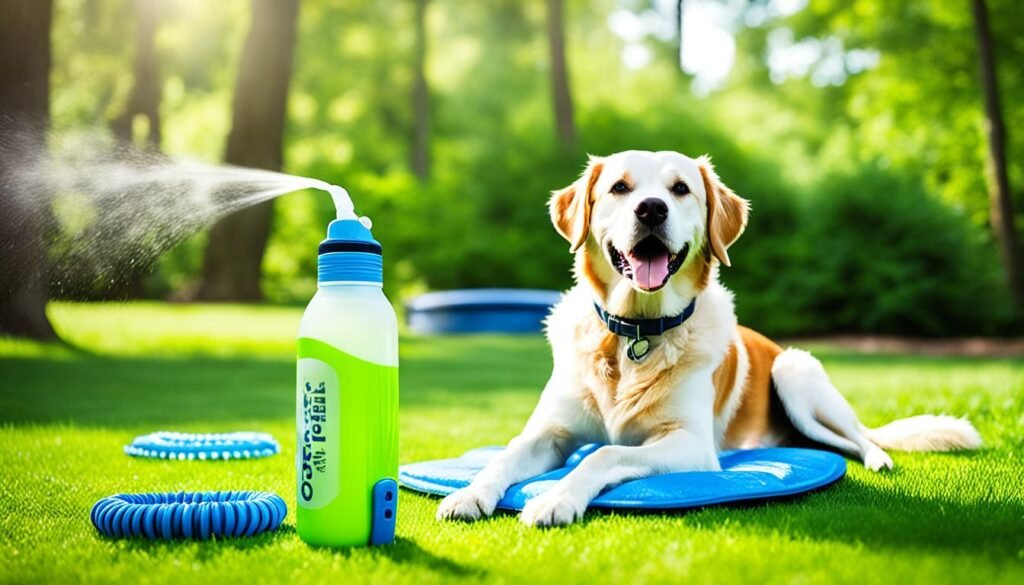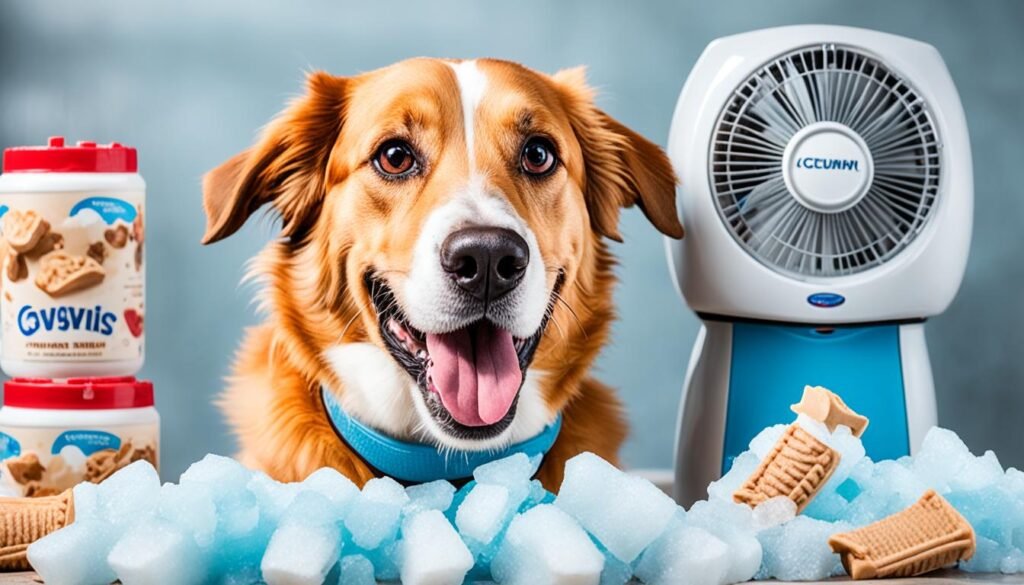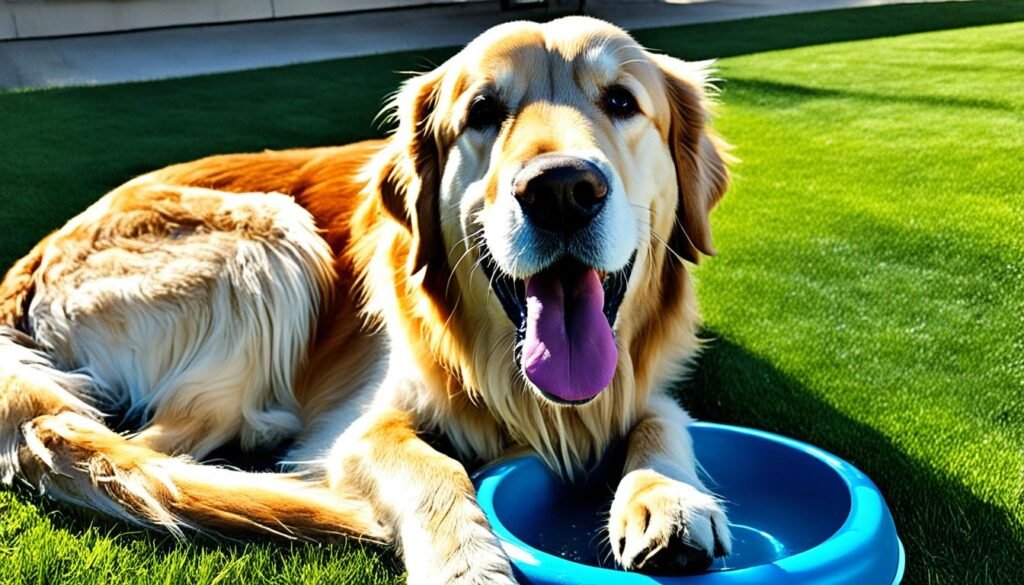As the scorching summer sun beats down, I can’t help but think of my beloved furry companion, Buddy, and how he must be feeling. Most dog breeds, like Buddy, are not built to dissipate heat effectively1. With their thick coats and lack of sweat glands, they are at a high risk of overheating and potentially life-threatening heatstroke. Keeping our canine friends cool during the summer months is not just a matter of comfort – it’s a crucial aspect of their health and well-being.
Key Takeaways
- Dogs have limited ability to dissipate heat and are at risk of heatstroke in the summer.
- Certain dog breeds, such as Chow Chows and Bulldogs, are more prone to heatstroke.
- Early recognition of heatstroke signs can save a dog’s life.
- Proper hydration, cooling accessories, and avoiding over-exercise are essential for keeping dogs safe in the heat.
- Monitoring your dog’s temperature and providing cooling relief can help prevent life-threatening heatstroke.
Why Keeping Your Dog Cool is Crucial
As pet owners, it’s critical to understand that dogs have a limited ability to dissipate heat compared to humans. Most dog breeds are designed to conserve rather than release heat, with a majority of their body covered in fur and lacking sweat glands2. Dogs primarily lose heat through panting and the pads of their feet, putting certain breeds, such as those with white or fine coats, short-nosed breeds, and those that are overweight or older, at a higher risk of developing heat-related illnesses like heatstroke2.
Dogs’ Limited Ability to Dissipate Heat
Recognizing the signs of heatstroke, which include rapid breathing, high body temperature, weakness, and disorientation, is crucial to preventing serious harm or even death2. A dog’s body temperature exceeding 106°F (with no known illness) is considered a heatstroke risk, and once it reaches around 107°F, multiple organ failure can occur, and death may follow2. Flat-faced (brachycephalic) dog breeds like French Bulldogs, Pugs, and Shih Tzus are particularly susceptible to these heat-related issues2.
To keep our canine companions safe during the hot summer months, understanding the dog heat risk factors, recognizing the signs of heat stroke in dogs, and taking proactive measures to cool them down are essential. By being informed and vigilant, we can ensure our furry friends stay healthy and comfortable, even in the warmest weather.

| Breed Prone to Heat Stroke | Cooling Accessories |
|---|---|
| Short-nosed breeds (Pugs, French Bulldogs, Shih Tzus) | Dog cooling vests, mats, pools, and fans |
| Overweight or older dogs | Cooling blankets for senior pets |
| Dogs with white or fine coats | Frozen bowls with toys, water, and low-sodium chicken broth, as well as fruits like cucumbers, watermelon, and apples |
By taking proactive steps to keep our dogs cool and hydrated during the summer months, we can help prevent heat-related illnesses and ensure their safety and comfort3. Investing in the right cooling accessories and understanding the dog heat risk factors can go a long way in protecting our beloved canine companions.
How to Keep a Dog Cool in Summer
As the summer heat intensifies, it’s crucial to ensure our canine companions stay cool and comfortable. From water-based cooling techniques to specialized accessories, there are numerous ways to beat the heat and prevent heat-related issues like dehydration and heatstroke4.
Water-based Cooling
Providing ample, fresh water is the foundation of keeping dogs hydrated and cool. Dogs should drink approximately 1 ounce of water (1/8 of a cup) per pound of body weight each day, especially crucial during hot weather4. Additionally, swimming, playing in sprinklers, or gently hosing down your dog can help lower their body temperature and provide relief from the scorching sun5.
Cooling Accessories
Investing in specialized cooling accessories can also be a game-changer for your canine companion. Elevated beds, cooling vests, collapsible water bowls, and kiddie pools are just a few examples of products designed to help dogs stay cool during the summer months4. Frozen treats like banana and peanut butter pupsicles can also aid in cooling down dogs from the inside out4.
It’s important to note that hairless breeds and dogs with white or light coats are the most susceptible to sun damage, requiring sun protection4. Additionally, caution should be exercised when walking dogs on hot pavement, as it can reach temperatures over 75°F, potentially causing burns to their paws4. In such cases, dog boots can provide an effective solution to protect their delicate feet4.
By incorporating these various dog cooling techniques, you can help your furry friend stay comfortable and safe throughout the summer season. Remember, prevention is key, and being proactive in keeping your dog cool can make all the difference in their health and well-being456.

Conclusion
Keeping your dog cool in the summer is crucial to their health and well-being7. By understanding the risks of heat-related illnesses, recognizing the signs of heatstroke, and implementing effective cooling strategies, you can help your furry friend stay comfortable and safe during the hot summer months7. Remember to always have plenty of cool water available7, provide shade and cooling accessories7, and limit exercise during the hottest parts of the day7. With the right precautions, you and your dog can enjoy a safe and enjoyable summer together.
Dogs’ ability to regulate their body temperature is limited, as they do not sweat through their skin and rely primarily on panting to cool down8. Certain breeds, such as brachycephalic dogs, are at a higher risk of overheating due to their shorter airways78., Additionally, puppies, senior dogs, and those with existing medical conditions or obesity are more prone to heat-related illnesses8. By recognizing the signs of heatstroke, such as excessive panting, increased salivation, and disorientation, you can act quickly to cool your dog down and seek veterinary care if necessary8.
To keep your dog cool, incorporate water-based cooling methods like cooling vests, mats, and collars, as well as use fans and misting systems to improve airflow and lower the temperature8. Avoid leaving your dog in a parked car, as temperatures can quickly reach dangerous levels, even on milder days78., By implementing these effective cooling strategies, you can help your dog stay comfortable and safe throughout the summer months. With the right precautions, you and your canine companion can enjoy a fun and healthy summer together.




